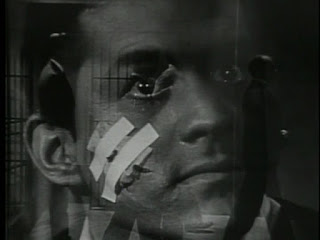We don't doubt that some of the themes we use for our posts seem a bit contrived. Truth is, with very rare exceptions, we try to review these movies in the order we watch them, so we'll seize upon anything -- no matter how slight -- to link a pair, trio, or quartet of films together for our purposes.
That said, these next two films have so much in common, you'd almost think you'd queued up the same movie twice in a row. It surely can't be a coincidence that Mill Creek paired them on one side of a disc, for both of them:
- have capital punishment as a central theme;
- open with an execution, including a radio broadcast that announces it;
- have a central character consumed by the injustice he believes he's suffered;
- have a sweet-natured dullard as a prominent secondary character;
- show a main character getting slashed by a broken bottle;
- and involve the framing of an innocent man who's ultimately slated for the electric chair unless something can be done.
Anatomy of a Psycho (1961)
Grade: C-
Angry young man Chet (Darrell Howe) is convinced his brother was wrongfully executed (he wasn't), and seeks revenge on those responsible. But -- what a twist! -- his sister (Pamela Lincoln) is in love with the son of the man whose eyewitness testimony put their brother away. What to do?
Something about Anatomy of a Psycho reminded us of Ed Wood's The Violent Years, so we were pleasantly surprised to learn that Wood may have had a hand in the script of this one too (though the connection is speculative). Of course Anatomy of a Psycho is a better film, but it's also less fun, though at least it has a real edge to its social commentary (unlike Wood's laughable subplot in The Violent Years about communist subversion via schoolroom vandalism).
As Chet, Howe certainly paints a reasonable picture of a man so fulminating with rage as to endanger his sanity -- not to mention his chums.
And there's a cruel logic to Chet's random acts of senseless violence, all of which seem targeted at a world that views him with disdain; though Anatomy of a Psycho is ostensibly a film about an unjust execution and the ensuing paroxysms of revenge, there's clearly a class warfare element in the mix as well.
But something about Anatomy of a Psycho never really engaged us. Maybe the protagonist is too unsympathetic, or the supporting cast too interchangeable; maybe the plot is just too predictable, without enough commitment to see its premise through to a more disturbing end; or maybe we should just watch Rebel Without a Cause or The Wild One again, for a reminder of what a good film about angst-filled hoods can be like.
Buried Alive (1939)
Grade: C+

Another site refers to Buried Alive as a "prison melodrama", and that's about right. Unlike Anatomy of a Psycho -- in which characters living on the outside spend much of their time thinking about those inside -- Buried Alive is set behind bars. Though many of its setpieces happen elsewhere, the prison is the nexus of all the film's activity.
Most of the film's major characters aren't prisoners, however, but prison staff -- among them a kindly chaplain, a friendly doctor, a tormented executioner, and an enlightened warden. All are committed to the penal system and want to see it work as a means of rehabilitation, not merely punishment.
For most of the staff, only one thing occupies their mind more than the prison and its workings, and that's Nurse Joan (Beverly Roberts). Nearly every major character turns out to be in love with her, though we struggle to see the charm -- she has one of those "12-year-old boy boasting about his Pokémon" voices that suggest fried dough sold via an unpowered vehicle, if you catch our drift (and unless you're us or Andrew, you probably don't).
Of course, with all those plum specimens of upstanding bachelorhood drooling over her, Nurse Joan insists on falling for the local bad-boy-with-a-heart-of-gold, Johnny (Paul Wilcox), instead. Convicted of some unspecified crime, he's in for a couple years but is a model prisoner due for imminent release.
And does he like her too? Well, you be the judge:
To the film's credit, not one of the heartbroken also-rans try to undermine Joan and Johnny's love: each recognizes when he's been licked, or at least loves Joan too much to want to sabotage her happiness.
Or maybe they're just offended seeing such a silly hat aboard a female who's only marginally spunky and certainly isn't a reporter -- who knows.
Instead, the drama in Buried Alive comes from a few unfortunate turns of events that -- coupled with the animus of an unscrupulous reporter and the jealous hatred of a sociopathic inmate -- threaten to ruin everything.
The anti-capital punishment, pro-prison reform message in Buried Alive is hard to miss. But as we've noticed in other films with a political subtext (Our Daily Bread comes to mind), it's otherwise quite optimistic about human nature. True, there will always be snakes in the grass --
-- but the film seems confident that, with the aid of courage and a little ingenuity, basic human decency will win out in the end. (Easy to do, and believe, when you're the one writing the script.)
Unfortunately the film's closing minutes are implausible enough (especially on second viewing) to risk squandering all the goodwill it's built up to that point. But Buried Alive is clearly a cut above the likes of Anatomy of a Psycho, and -- even if it takes a few missteps along the way -- its affirming vision of the world feels reasonably well-earned.















No comments:
Post a Comment